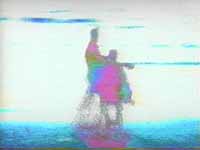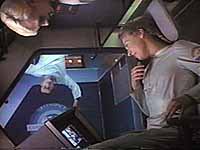
































| The Disease of Images
Wim Wender's Until the End of the World by Toni Perrine |
|
Go to:
|
Like many films directed by Wim Wenders, Until the End of the World (1991) is all about vision, desire and movement. It is also consistent with Wenders' tendency to have characters deal with each other indirectly, through pictures, phone messages, notes and intermediaries. It contains the visual and narrative restlessness of the German filmmaker's films, but in a new departure for Wenders, Until the End of the World privileges narrative over visual elements, even suggesting that only stories can cure "the disease of images" that ravages postmodern culture. |
|
The immediate threat of nuclear annihilation underlies the film's chase-conspiracy-romance plot which takes place across ten different countries. A massively ambitious project for Wenders, Until the End of the World is an Australian-German-French coproduction with an international cast. Multinational corporations like Sony and Sharp contributed the high definition video dream sequences that are foregrounded in the last third of the film, when it becomes a slower paced meditation on universal human experiences including dreams, memory, sorrow and death. The "end of the world" scenario is significant because it is the backdrop against which the actions of the characters occurs and is interpreted. It signifies the destructive power of the technology we have created which may ultimately overwhelm us. Until the End of the World simultaneously embraces technology and rejects it, a contradiction that can be said to replicate larger cultural concerns.
Until the End of the World (UTEOTW) shows both the beneficial and destructive capabilities of technology. It ultimately privileges the centrality of human relationships which are nonetheless inseparable from their technological context. In addition, the film plays on the idea of romance that can last for all time, or "until the end of the world." This promise of timeless romance between individuals is not kept, but human relationships do endure, sometimes through technological means.
The threat posed by technology is immediately a primary concern of UTEOTW; it is the first fact established by the voice-over narration which begins "1999. The year the Indian nuclear satellite went out of control. It soared over the ozone layer like a lethal bird of prey. No one knew where it would land. The whole world was alarmed." Here, nuclear disaster develops in a political void. It is the uncontrollable accident which most people fear more than full scale nuclear war.
Later, Claire tracks Sam via computer when he uses his credit cards to travel around Europe, and she follows him literally around the world in order to satisfy her desire to know more about him. In fact, most of their contact through the first third of the film is made possible by advanced computer technology. Sophisticated software with graphics similar to current computer programs make the necessary deductions to establish Sam's true identity and current location.
Despite the fact that he betrays her several times, Claire continues to help Sam through a series of distinctly playful chase sequences across various European and Asian locations including Lisbon, Berlin, Paris, Moscow, Beijing and Tokyo. Sam's journey to collect images with the sophisticated camera developed by his father is complicated by a conspiracy subplot in which Sam is pursued by bounty hunters who seek a reward offered by the U.S. government for return of the camera. Recording the images is physically debilitating and Sam's own eyesight begins to fail. After helping him regain his vision with a traditional herbal treatment, Claire uses the camera to help Sam gather family pictures.
The images collected, and various pursuers evaded, Claire and Sam travel to Australia where Sam's parents live with a tribe of aborigines who help Dr. Henry Farber (Max Von Sydow) with his research. En route, Sam and Claire experience the effects of the electromagnetic pulse that accompanies nuclear explosions. The EMP effect forces a return to earlier, simpler forms of technology, like the hand-cranked engine and the manual typewriter.
In a new series of experiments, Claire, Henry and Sam become addicted to their own dream images and become oblivious to other people. Each is eventually cured of their addiction (the disease of images), but there is no repairing the damaged relationships and the characters go their separate ways. The final images of the film show Claire aboard a satellite working for Greenspace, free from the laws of gravity and from most human contact except via satellite.
The film also offers an essentially positive representation of human agency. Although involved in various nefarious activities, the characters are basically generous in spirit. Eventually, all of the main characters, who represent several nations and cultures, come together in Australia to celebrate the beginning of the new century together. The film suggests that humans can adapt and retain their humanity in a rapidly changing world. Thus the interaction with, and resistance to, technology forms an important part of the film's discourse.
It seems inevitable that Claire be afflicted by the disease of images since it is her vision that structures much of the narrative. She is frequently shown recording her surroundings with a hand-sized video camera, in effect, experiencing the physical world second-hand through electronic mediation. Claire is the perfect candidate for the dream experiments because the computer considers her "technically compatible." The book Gene (Sam Neill) struggles to write throughout the film, entitled A Dance Around the Planet, tells Claire's story. Claire is cured of the disease of images when she reads the book, a testimony to Wenders' newfound belief in the healing power of words and stories.
The exhilarating, exotic but exhausting journeys taken by the characters, both physically and psychically, structure the film as an expansive road movie that ends in a very different place from where it began. In UTEOTW, the cities of the world fall away to backdrops, decayed and corrupt, existing only as places to leave. The characters discover there is no home to return to and must flee the earth or seek a nostalgic past, to escape stasis and achieve transitory redemption.
UTEOTW recapitulates the road movie, questions the possibility of romantic renewal and interrogates technology. A technological product itself, the film simultaneously embraces technology and warns of its dangers. Its attempt to mediate these contradictory impulses are not completely successful. Like other Wenders' films, UTEOTW ends with a continuation of the journey, a rootlessness depicted in the final shots of Claire orbiting the Earth.
Toni Perrine is an assistant professor of film and video at Grand Valley State University in Allendale, Michigan. She is currently working on a manuscript called "Beyond Apocalypse: Representations of Nuclear Disaster in Film." Photo Credits: Warner Home Video. |
 |
 |
 |
 |
 |
 |
 The futuristic mise-en-scene of Until the End of the World, in which advanced computer technology is foregrounded, situates the film generically as science fiction. Technology is simultaneously central to the end of the world scenario, used to produce hypnotically beautiful dream images, crucial to forming and maintaining human relationships and responsible for the devastation and transformation of those relationships. This reading of the film will focus on the complex and contradictory use of advanced technology as central plot device and theme.
The futuristic mise-en-scene of Until the End of the World, in which advanced computer technology is foregrounded, situates the film generically as science fiction. Technology is simultaneously central to the end of the world scenario, used to produce hypnotically beautiful dream images, crucial to forming and maintaining human relationships and responsible for the devastation and transformation of those relationships. This reading of the film will focus on the complex and contradictory use of advanced technology as central plot device and theme.
 The relationship between Claire (Solveig Dommartin) and Sam (William Hurt) is continually linked to technological innovations that viewers accept as probable within a few years' time. Claire first encounters Sam when both are using videophones in a trashed urban setting. This sequence foregrounds the excessive materiality of the postindustrial age. The stranger complains of some eye irritation and Claire checks his eyes in a lover-like posture. Their first encounter thus foregrounds romance, technology and vision, the elements that will continue to define their relationship throughout the film.
The relationship between Claire (Solveig Dommartin) and Sam (William Hurt) is continually linked to technological innovations that viewers accept as probable within a few years' time. Claire first encounters Sam when both are using videophones in a trashed urban setting. This sequence foregrounds the excessive materiality of the postindustrial age. The stranger complains of some eye irritation and Claire checks his eyes in a lover-like posture. Their first encounter thus foregrounds romance, technology and vision, the elements that will continue to define their relationship throughout the film.
 Their relationship is sustained when Claire helps Sam collect images with a high tech camera that records not only pictures but brain waves which will allow Sam's blind mother to see again. It is the invasive capabilities of this camera/computer technology and the addictive effect of the images produced by it that eventually destroy the film's primary relationships between husband and wife, between parent and child and between lovers. Thus, an ostensibly benign technological innovation ultimately poses a greater threat than nuclear weapons.
Their relationship is sustained when Claire helps Sam collect images with a high tech camera that records not only pictures but brain waves which will allow Sam's blind mother to see again. It is the invasive capabilities of this camera/computer technology and the addictive effect of the images produced by it that eventually destroy the film's primary relationships between husband and wife, between parent and child and between lovers. Thus, an ostensibly benign technological innovation ultimately poses a greater threat than nuclear weapons.
 Assuming the worst and totally cut off from the rest of the world, Dr. Farber nonetheless insists upon the completion of his research so that his wife Edith (Jeanne Moreau) might see once more. Conflict between father and son is readily apparent, and is both the cause and the result of Sam's inability to concentrate enough to transmit the bioelectronic images to his mother. Claire once again helps Sam by taking his part in the experiment which then concludes successfully. On December 31, 1999, the research camp learns that the world has escaped nuclear devastation even as Edith dies from her sorrow over how the visible world has changed since her youth.
Assuming the worst and totally cut off from the rest of the world, Dr. Farber nonetheless insists upon the completion of his research so that his wife Edith (Jeanne Moreau) might see once more. Conflict between father and son is readily apparent, and is both the cause and the result of Sam's inability to concentrate enough to transmit the bioelectronic images to his mother. Claire once again helps Sam by taking his part in the experiment which then concludes successfully. On December 31, 1999, the research camp learns that the world has escaped nuclear devastation even as Edith dies from her sorrow over how the visible world has changed since her youth.
 On one level, the film is embedded in postmodern culture: the main characters ignore the world crisis in their pursuit of individual goals, humans are alienated from each other and their environs frequently through technological means (their individual cars and computer systems, for example), there is a loss of diverse human experience in an increasingly global culture, and paranoia reigns supreme (everyone is suspicious of the motivations of others, often with good cause). The "disease of images" experienced by Claire and Sam suggests the power and potential danger of mediated visual communication in western culture. Each of the characters afflicted with the disease of images must seek spiritual cures.
On one level, the film is embedded in postmodern culture: the main characters ignore the world crisis in their pursuit of individual goals, humans are alienated from each other and their environs frequently through technological means (their individual cars and computer systems, for example), there is a loss of diverse human experience in an increasingly global culture, and paranoia reigns supreme (everyone is suspicious of the motivations of others, often with good cause). The "disease of images" experienced by Claire and Sam suggests the power and potential danger of mediated visual communication in western culture. Each of the characters afflicted with the disease of images must seek spiritual cures.
 Quite a bit of scientific sounding exposition is provided to explain how the process of recording dream images works, but finally the viewer, like the characters, gets lost in the images themselves, which stay on the screen for long moments, mesmerizingly obscure, then fleetingly clear, very much like dreams. Generated on HDTV equipment, they are ephemeral and often painful visions of childhood, separation and loss. The impressionistic dream sequences are among the most beautiful in the film but are also the most dangerous to the characters, who must be rescued from "drowning in their own nocturnal imagery." Initially Claire attempts to resist their hypnotic power but this effort is feeble and short-lived.
Quite a bit of scientific sounding exposition is provided to explain how the process of recording dream images works, but finally the viewer, like the characters, gets lost in the images themselves, which stay on the screen for long moments, mesmerizingly obscure, then fleetingly clear, very much like dreams. Generated on HDTV equipment, they are ephemeral and often painful visions of childhood, separation and loss. The impressionistic dream sequences are among the most beautiful in the film but are also the most dangerous to the characters, who must be rescued from "drowning in their own nocturnal imagery." Initially Claire attempts to resist their hypnotic power but this effort is feeble and short-lived.